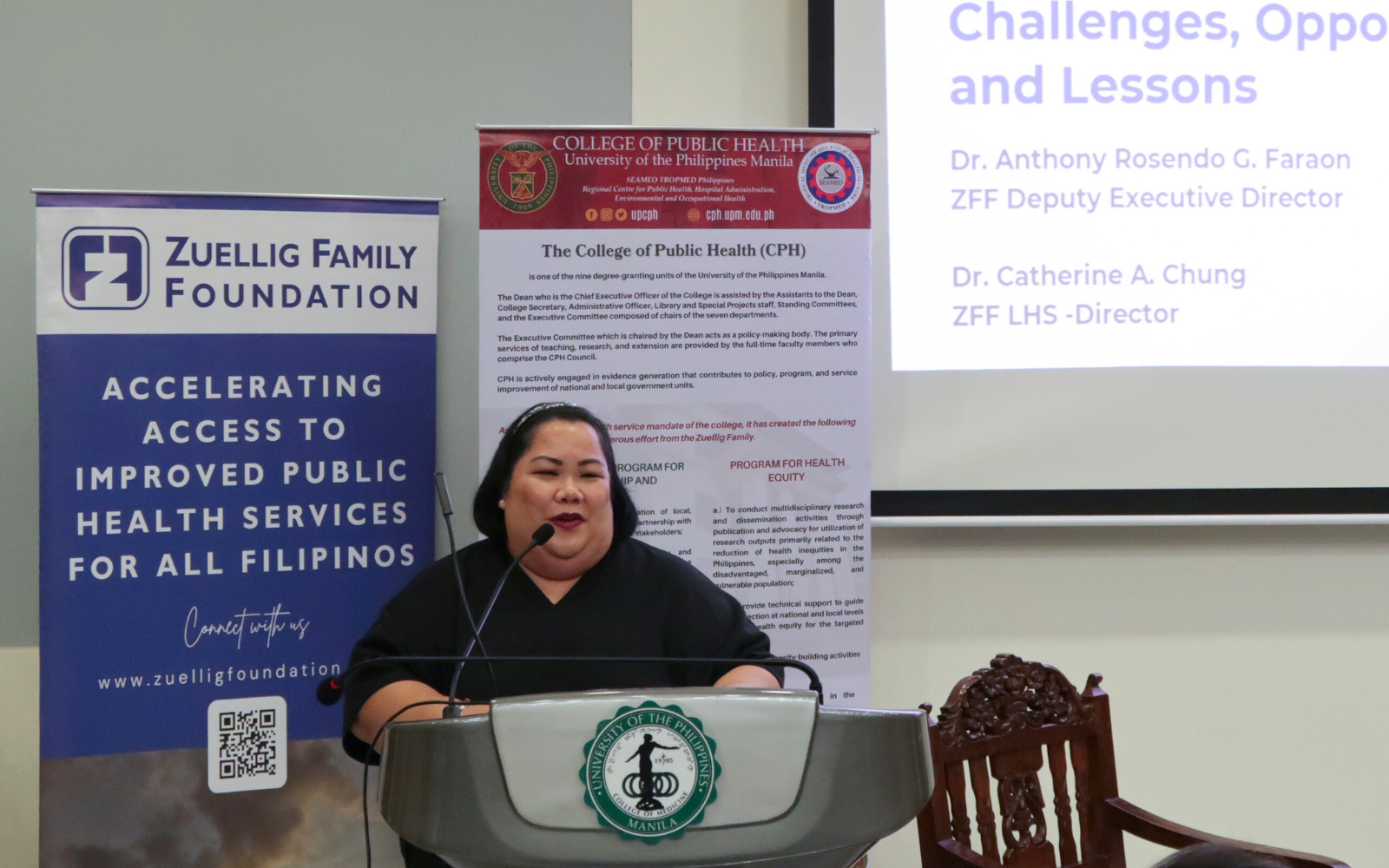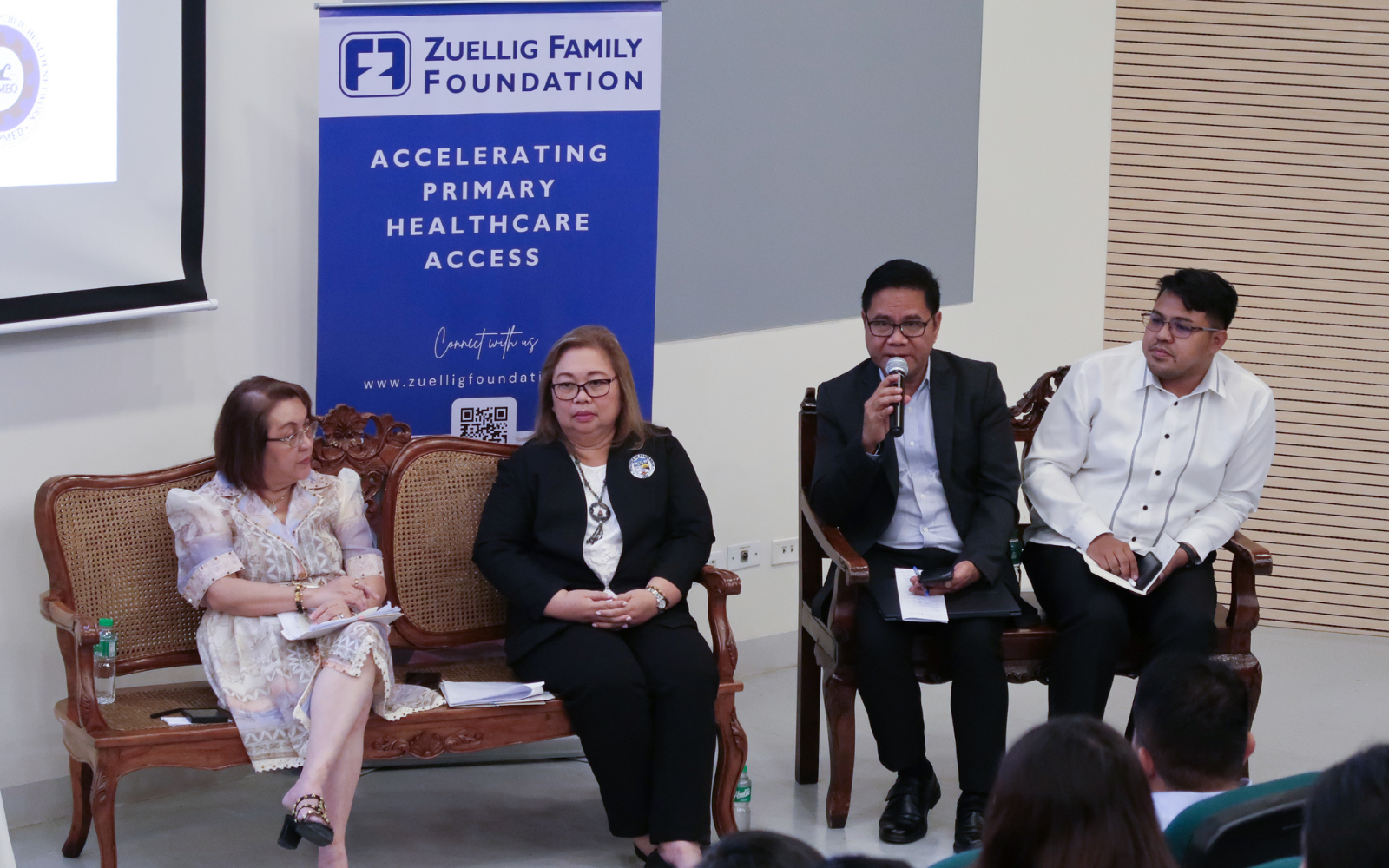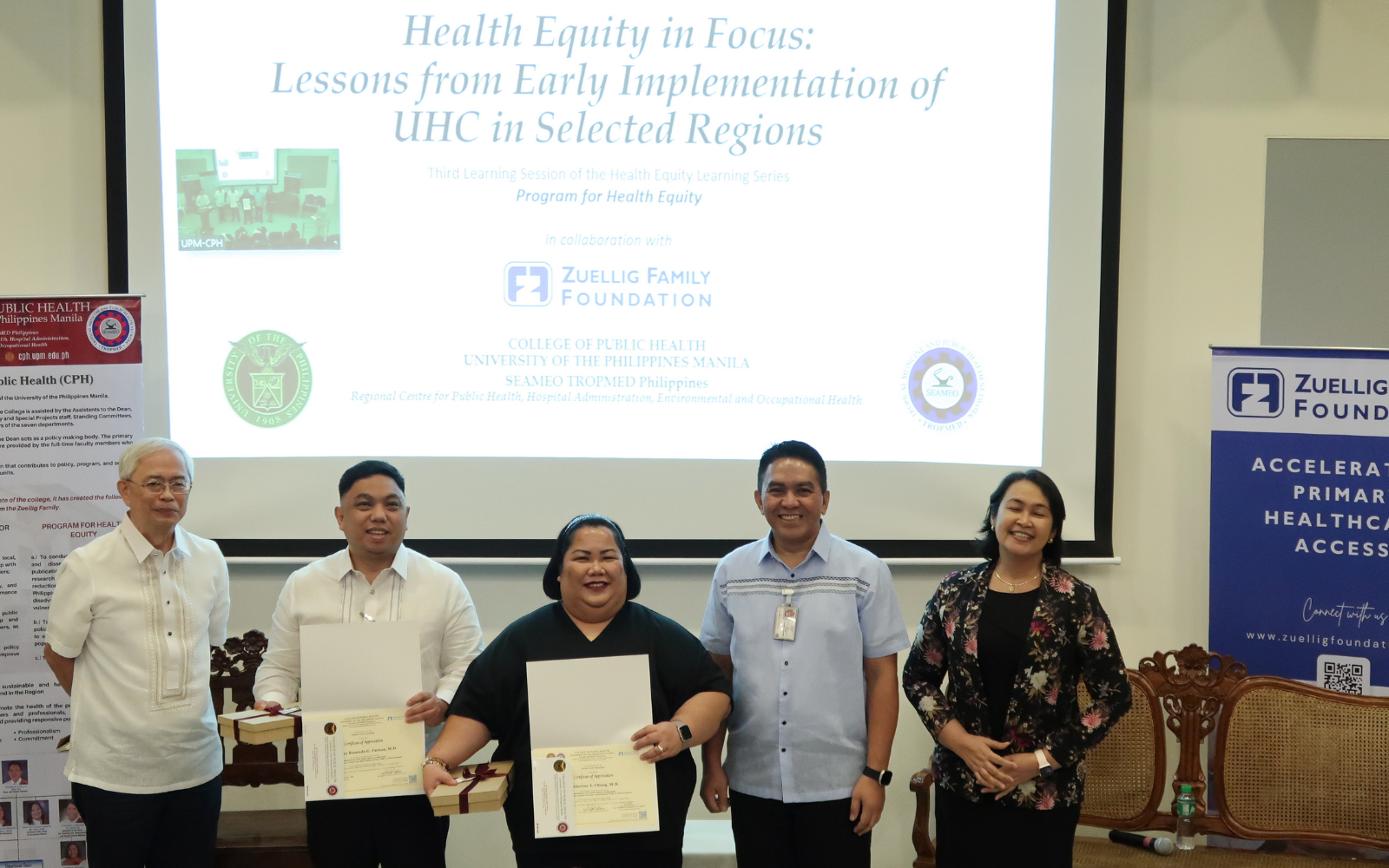Bridging the Gap: Challenges and Progress in Philippines’ Universal Health Care Implementation
Insights from the Field

Author: Dr. Catherine Chung, ZFF LHS Portfolio Director
The promise of universal health care (UHC) in the Philippines represents one of the country’s most significant reforms, aimed at ensuring that every Filipino has access to essential health services without the burden of financial hardship. A webinar, held on August 15, 2024, by the Zuellig Family Foundation’s (ZFF) Local Health System Portfolio in collaboration with the University of the Philippines College of Public Health, provided an overview of the progress made in five selected regions (CAR, Ilocos, Cagayan Valley, CALABARZON, and Eastern Visayas) under the DOH-ZFF Bayang Malusog Program.
The webinar focused on the accomplishments in primary care on the ground, which include accreditation and licensing of primary care facilities and the implementation of Konsultasyong Silt at Tama (KONSULTA), a comprehensive outpatient benefits program by PhilHealth. The discussion spotlighted progress but it also illuminated the disparities that persist between policy and practice. While most regions have achieved the target organizational level of 70% UHC maturity by the end of 2023, the webinar discussion shows that full integration is still a work in progress. Full integration of UHC is targeted to be achieved by 2029 and while the timeline is still far off, the local government units and DOH Center for Health and Development offices (DOHCHD) are working closely to achieve its targets. The availability of primary care services in the community is critical in terms of making accessible healthcare felt on the ground.
Performance of regions in KONSULTA accreditation
For the webinar, we determined the progress of our partner regions by gathering and analyzing the available data from PhilHealth as of December 31, 2023. The partner regions have accredited approximately 622 primary care facilities (PCFs), with the majority being government-owned and only 10% being privately-owned. These are only 51% of the estimated needed PCFs by 2025 and nine of the ZFF Local Health System (LHS) areas have no private KONSULTA provider. Given this, it is important to involve the private sector to help provide necessary health services to serve the entire population.
Notably, Region 4A (CALABARZON) boasts the highest number of accredited KONSULTA providers, while the Cordillera Administrative Region (CAR) has the least number. Of the 25 LHS provinces only nine or 36%, have successfully achieved accreditation.
Three factors have contributed to the progress made by local government units (LGUs).
- In some regions like CAR, harmonized accreditation and licensing processes, coupled with the collaboration between regional health authorities and PhilHealth, have streamlined compliance efforts.
- Strong leadership from local governors, who encouraged mayors to ensure that health facilities are both licensed and accredited, plays a pivotal role.
- The inclusion of PhilHealth in the province’s UHC Core Group further enhanced the efficiency of the accreditation process.
Despite these advancements, challenges persist. Some LGUs reported unclear communication regarding the accreditation process and requirements during the initial phase of UHC implementation. Additionally, ongoing construction of Rural Health Units (RHUs) and the lack of personnel to manage the accreditation process have hindered progress in certain areas.

Perfomance of regions in PhilHealth registration
To ensure high-quality primary care services, PhilHealth mandated the registration and assignment of beneficiaries to accredited PCFs to ensure the high quality of primary care services. When making this decision, PhilHealth accounted for both the beneficiaries’ preferences and the maximum catchment population, also known as the committed annual load (CAL). However, only 12 million people, or about 46% of the total population, have registered in the LHS areas. Region 4A, despite having the highest number of registered beneficiaries, covers only 29% of its population. Pangasinan leads with 2.5 million registered beneficiaries, followed by Laguna (1.5 million) and Leyte (1.1 million). In terms of registration rates, Mountain Province stands out with a 102% registration rate, attributed to a comprehensive barangay-level campaign and rigorous data monitoring.
KONSULTA Implementation Data Summary
- Primary Care Provider Network (sandbox): Baguio City and Quezon exceeded PCPN targets, with 137,208 registered and 733,356 registered respectively.
- Health Care Provider Network Demo site: Only Aklan and Benguet registered more than half of their population, Laguna had the lowest with 44%.
- KONSULTA regular: Over half of remaining LHS areas registered at least half of their population, with Mountain Province having the highest rate.
In terms of facility type, the majority are registered in accredited government health facilities (96%), and about 64% are registered in RHUs since there are more accredited government health facilities than private facilities. It is also critical to note that, among the areas, Pangasinan and the three Samar provinces have a higher registration rate in hospitals than in RHUs.
Several best practices emerged from the webinar, highlighting strategies that have aided LGUs. These include engaging non-health sectors like the Philippine National Police (PNP) and Barangay Federated Presidents (BFP) in the registration process, implementing a Center for Health Development (CHD) program requiring all employees to register and complete the First Patient Encounter (FPE), and securing strong support from provincial governments for health advocacy and outreach activities. Additionally, PhilHealth’s one-barangay-at-a-time (OBAT) approach, which was piloted in North Samar, significantly accelerated KONSULTA implementation and yielded the highest FPE capitation in the Eastern Visayas Region.
However, the journey towards providing access to primary care services thru PhilHealth’s KONSULTA is not without its obstacles. IT system issues, including frequent outages and slow operations, have impeded the encoding of registration and FPE records. Moreover, a lack of public awareness about the health services offered at PCFs, coupled with registration challenges related to PhilHealth Identification Numbers (PINs), further complicates the process. As a result, only 7% (857,789) of the 12 million registered beneficiaries across all LHS areas had undergone FPE in 2023, with Region 1 (Ilocos Region) having the highest FPE completion rate.

Policy versus Practice
Despite the commendable legislative framework that underpins UHC and other policies supporting the law, the reality on the ground reveals that many Filipinos, particularly those in underserved and rural areas, continue to struggle with access to free, quality healthcare. The webinar underscored the various challenges that hinder effective implementation of PhilHealth’s KONSULTA, which has resulted in slow integration of health services across the public and private sectors and exacerbate disparities, leaving vulnerable populations at risk. Due to ongoing delays and challenges in uploading claims, coupled with glitches in the health information system supporting primary care facilities, the presentation has yet to fully capture the true scope of the situation. Despite these setbacks, leaders remain hopeful that these claims will play a critical role in securing funding to enhance health services for vulnerable populations. Along with data from KONSULTA registration and FPE, the indicators included in the DOH-LHS Maturity Level will provide a clearer picture of the implementation of the Universal Health Care (UHC) law.
While the Philippines has made significant progress in its journey toward Universal Health Care (UHC), disparities in policy execution highlight the need for a more targeted and inclusive approach. Beyond the previously discussed aspects, the successful integration of UHC requires attention to technical, managerial, and financial challenges. Five years into the implementation of the UHC law, the country remains far from fully achieving its goal of equitable and accessible healthcare for all. Many Filipinos, our Juan and Juanas, continue to hope for healthier and better lives. Overcoming these challenges will demand strong political will, effective governance, and the active engagement of all stakeholders. Only through such collective efforts can we truly realize the vision of UHC, ensuring that no Filipino remains behind.